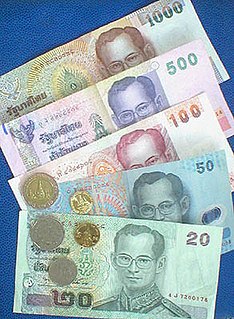
Baht is the official currency of Thailand. It is subdivided into 100 satang. The issuance of currency is the responsibility of the Bank of Thailand.
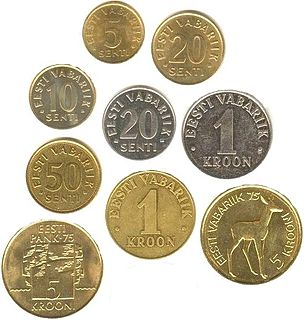
The kroon was the official currency of Estonia for two periods in history: 1928–1940 and 1992–2011. Between 1 January and 14 January 2011, the kroon circulated together with the euro, after which the euro became the sole legal tender in Estonia. The kroon was subdivided into 100 cents. The word kroon is related to that of the Nordic currencies and derived from the Latin word corona ("crown"). The kroon succeeded the mark in 1928 and was in use until the Soviet invasion in 1940 and Estonia's subsequent incorporation into the Soviet Union when it was replaced by the Soviet ruble. After Estonia regained its independence, the kroon was reintroduced in 1992.

The Russian ruble or rouble is the currency of the Russian Federation, the two partially recognised republics of Abkhazia and South Ossetia and the two unrecognised republics of Donetsk and Luhansk. The ruble is subdivided into 100 kopeks.

The tenge is the currency of Kazakhstan. It is divided into 100 tıyn. The ISO-4217 code is KZT.
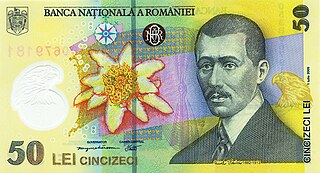
The Romanian leu is the currency of Romania. It is subdivided into 100 bani, a word that is also used for "money" in the Romanian language.

The dram is the monetary unit of Armenia and the neighboring unrecognized Republic of Artsakh (Nagorno-Karabakh). It was historically subdivided into 100 luma. The word "dram" translates into English as "money" and is cognate with the Greek drachma and the Arabic dirham, as well as the English weight unit dram. The first instance of a dram currency was in the period from 1199 to 1375, when silver coins called dram were issued.
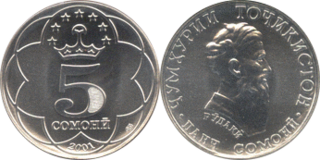
The somoni is the currency of Tajikistan. It is subdivided into 100 diram. The currency is named after the father of the Tajik nation, Ismail Samani.
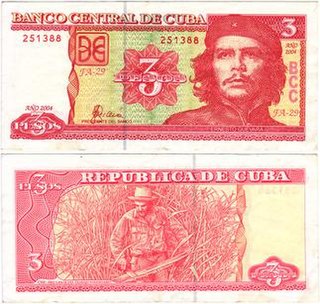
The peso is one of two official currencies in use in Cuba, the other being the convertible peso. There are currently 25 CUP per CUC.

The ruble is the currency of Transnistria and is divided into 100 kopecks. Since Transnistria is a state with limited international recognition and considered as part of Moldova, its currency has no ISO 4217 code. However, unofficially some Transnistrian organisations such as Agroprombank and Gazprombank used the code PRB, a code that would otherwise be reserved for Puerto Rico. The Trans-Dniester Republican Bank sometimes uses the code RUP.

The som is the currency of the Kyrgyz Republic.

The Canadian five-cent coin, commonly called a nickel, is a coin worth five cents or one-twentieth of a Canadian dollar. It was patterned on the corresponding coin in the neighbouring United States. It became the smallest-valued coin in the currency upon the discontinuation of the penny in 2013. Due to inflation, the purchasing power of the nickel continues to drop and currently the coin represents less than 0.5% of the country's lowest minimum hourly wage.

The Belarusian ruble or rouble is the official currency of Belarus. The ruble is subdivided into 100 copecks.
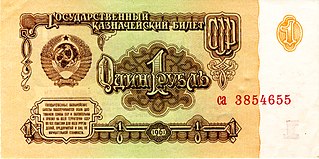
The Soviet ruble was the currency of the Union of Soviet Socialist Republics (USSR). One ruble was divided into 100 kopeks. Many of the ruble designs were created by Ivan Dubasov. The production of Soviet rubles was the responsibility of the Federal State Unitary Enterprise, or Goznak, which was in charge of the printing of and materials production for banknotes and the minting of coins in Moscow and Leningrad. In addition to regular currency, some other currency units were used, such as several forms of convertible ruble, transferable ruble, clearing ruble, Vneshtorgbank cheque, etc.; also, several forms of virtual rubles were used for inter-enterprise accounting and international settlement in the Comecon zone. In 1991, after the breakup of the USSR, the Soviet ruble continued to be used in the post-Soviet states, forming a "ruble zone", until it was replaced with the Russian ruble by 1993.
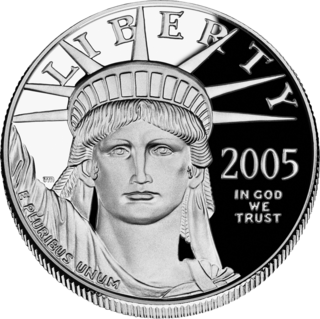
Platinum coins are a form of currency. Platinum has an international currency symbol under ISO 4217 of XPT. The issues of legitimate platinum coins were initiated by Spain in Spanish-colonized America in the 18th century and continued by the Russian Empire in the 19th century. As a form of currency, these coins proved to be impractical: platinum resembles many less expensive metals, and, unlike the more malleable and ductile silver and gold, it is very difficult to work. Several commemorative coin sets have been issued starting from 1978 and became popular among coin collectors. The major platinum bullion coins include the American Platinum Eagle, the Canadian Platinum Maple Leaf, the Australian Platinum Koala, the Isle of Man Noble, the Chinese Platinum Panda and several series by the Soviet Union and later by the Russian Federation.
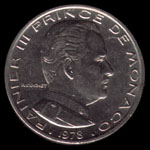
The franc was the official currency of the Principality of Monaco until 1995, when it changed to the French franc. The franc was subdivided into 100 centimes or 10 décimes. The Monégasque franc circulated alongside the French franc with the same value. Like the French franc, the Monégasque franc was revalued in 1960 at a rate of 100 old francs = 1 new franc. The official euro-to-franc exchange rate was MCF 6.55957 to EUR 1.

Bi-metallic coins are coins consisting of two (bi-) metals or alloys, generally arranged with an outer ring around a contrasting center. Common circulating examples include the ₹10, €1, €2, 2 and 5 PLN, 50 CZK, 100 and 200 HUF, 1 and 2 BGN, United Kingdom £1 and £2, Canadian $2, South African R5, Turkish 1 lira, IDR 1K, Hong Kong $10, Argentine $1 and $2, Brazilian R$1, Chilean $100 and $500, Colombian $500 and $1000, and all Mexican coins of $1 or higher denomination.
The bi-metallic Thailand ten-baht coin is a denomination coin of the Thai Baht, the currency unit of Thailand.

The 2013 Summer Universiade, officially known as the XXVII Summer Universiade, was held in the city of Kazan, Russia, the most northerly city ever to host a Summer Universiade. Over 10,400 university athletes from 162 countries participated in 13 mandatory and 14 optional sports, making the 2013 Universiade the biggest ever in the history of the event. For the first time in history a Cultural Universiade was also included, with many festivals and shows held simultaneously with the sporting events. The Universiade was organized by the International University Sports Federation (FISU) and by the authorities of the Republic of Tatarstan.

The Brazilian real is the official currency of Brazil. It is subdivided into 100 centavos. The Central Bank of Brazil is the central bank and the issuing authority. The real replaced the Brazilian cruzeiro.